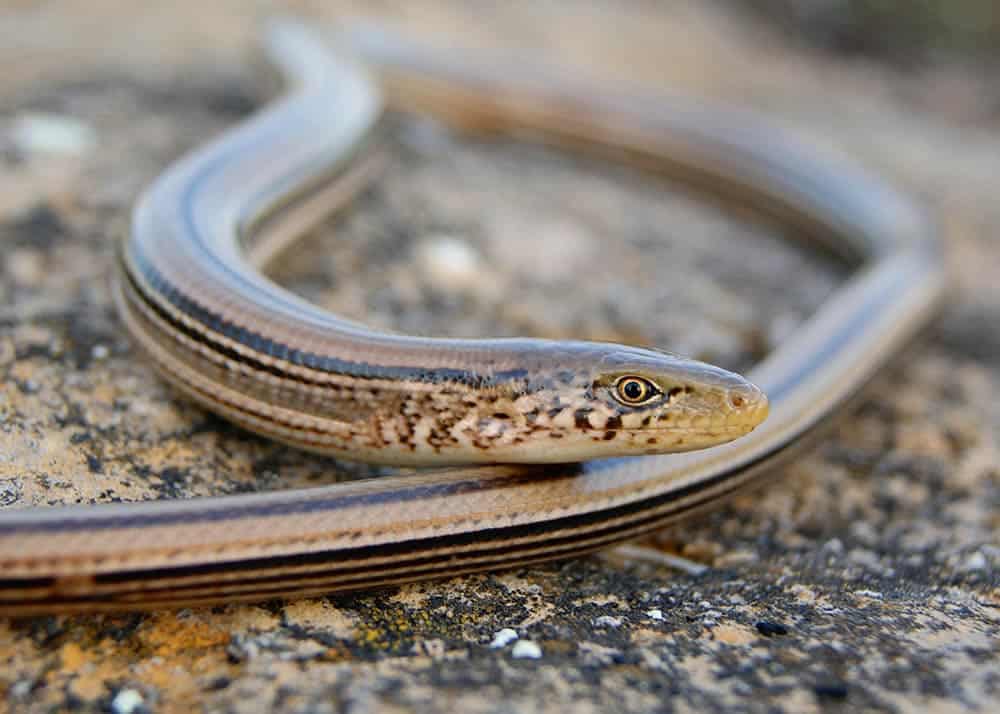Whether you are visiting Kansas and plan to do some sightseeing or you live there and found something strange in your yard, it can be helpful to know the different lizard species native to the area, especially if some of them are poisonous. Keep reading while we list 13 different species of lizard that you might encounter while you visit Kansas. For each entry, we’ll include an image and a short description so you can learn more about them.

The 13 Lizards Found in Kansas
1. Slender Glass Lizard

| Species: | Ophisaurus attenuatus |
| Longevity: | 10–30 years |
| Good to own as a pet?: | Yes |
| Legal to own?: | Yes |
| Adult size: | 25–30 inch |
| Diet: | Carnivorous |
The Slender Glass Lizard is native to eastern Kansas, and it’s relatively easy to find. It gets its name from how easy it is to break off its tail. It can make a great pet if you are careful with it.
2. Ground Skink

| Species: | Scincella lateralis |
| Longevity: | 2 years |
| Good to own as a pet?: | No |
| Legal to own?: | Yes |
| Adult size: | 3–6 inches |
| Diet: | Carnivorous |
You can find the Ground Skink buries in the loose rubble of the forest floor in southeastern Kansas. It doesn’t climb trees like other skinks, and it hibernates during the colder months.
3. Prairie Skink

| Species: | Scincella lateralis |
| Longevity: | 5–7 years |
| Good to own as a pet?: | No |
| Legal to own?: | Yes |
| Adult size: | 5–9 inches |
| Diet: | Carnivorous |
Kansas is unique in that you can find both the northern and southern versions of the Prairie Skink in the same state. These animals are great burrowers and can put themselves below the frost line. Their range is only as wide as a state but extends through the United States from north to south.
4. Great Plains Skink
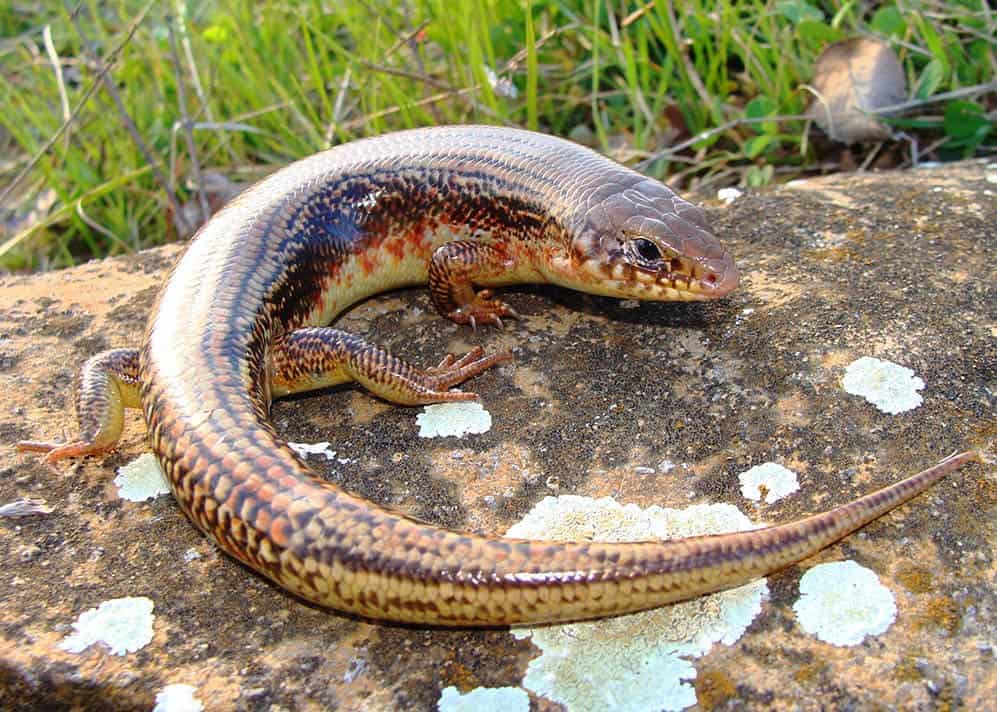
| Species: | Scincella lateralis |
| Longevity: | 3–8 years |
| Good to own as a pet?: | No |
| Legal to own?: | Yes |
| Adult size: | 10–14 inches |
| Diet: | Carnivorous |
The Great Plains Skink is one of the largest lizards you can find in Kansas. You can find it almost anywhere in the state, and it likes the open plains and foothills where you will find it near water.
5. Broad-Headed Skink
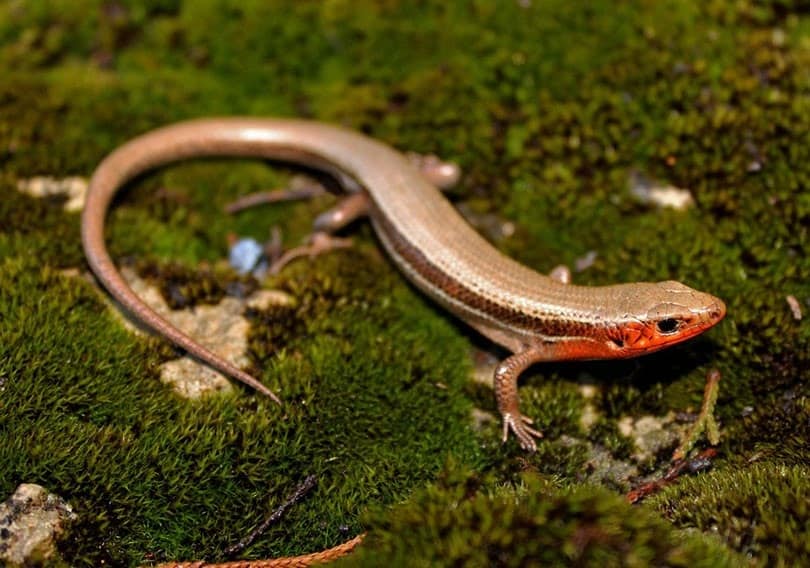
| Species: | Plestiodon laticeps |
| Longevity: | 4 years |
| Good to own as a pet?: | No |
| Legal to own?: | Yes |
| Adult size: | 10–13 inches |
| Diet: | Carnivorous |
The Broad-Headed Skink is similar to the Great Plains Skink and is almost as large. It gets its name from its wide jaws that give it a triangular head. You can find it all over Kansas, foraging around humid forests.
6. American Five-Lined Skink
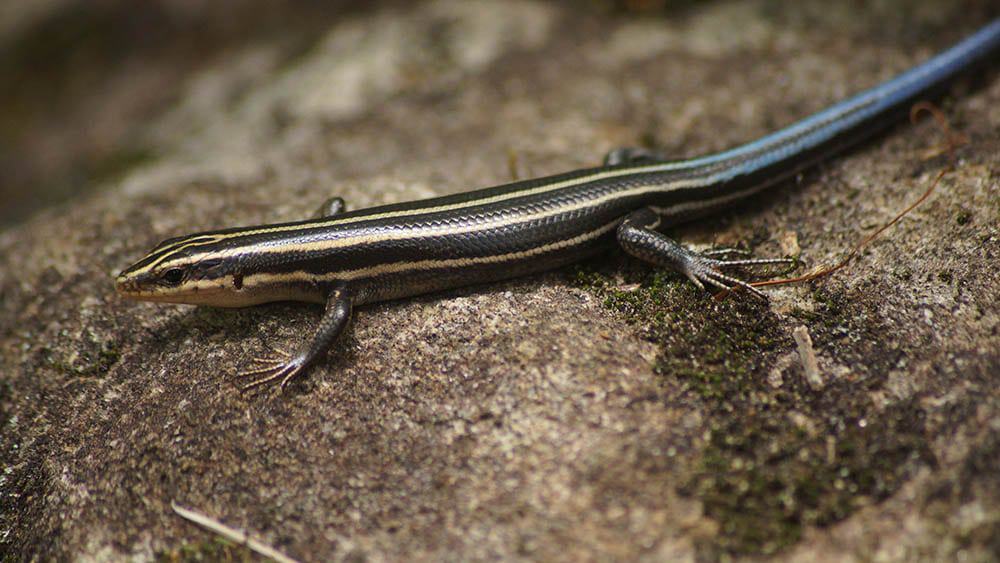
| Species: | Plestiodon fasciatus |
| Longevity: | 6 years |
| Good to own as a pet?: | No |
| Legal to own?: | Yes |
| Adult size: | 5–9 inches |
| Diet: | Carnivorous |
The American Five-Lined Skink is also called the Red Headed Skink due to the red coloring it achieves when it’s an adult. You can usually find it in the eastern part of Kansas, where it likes to hide in walls, buildings, and trees.
7. Coal Skink
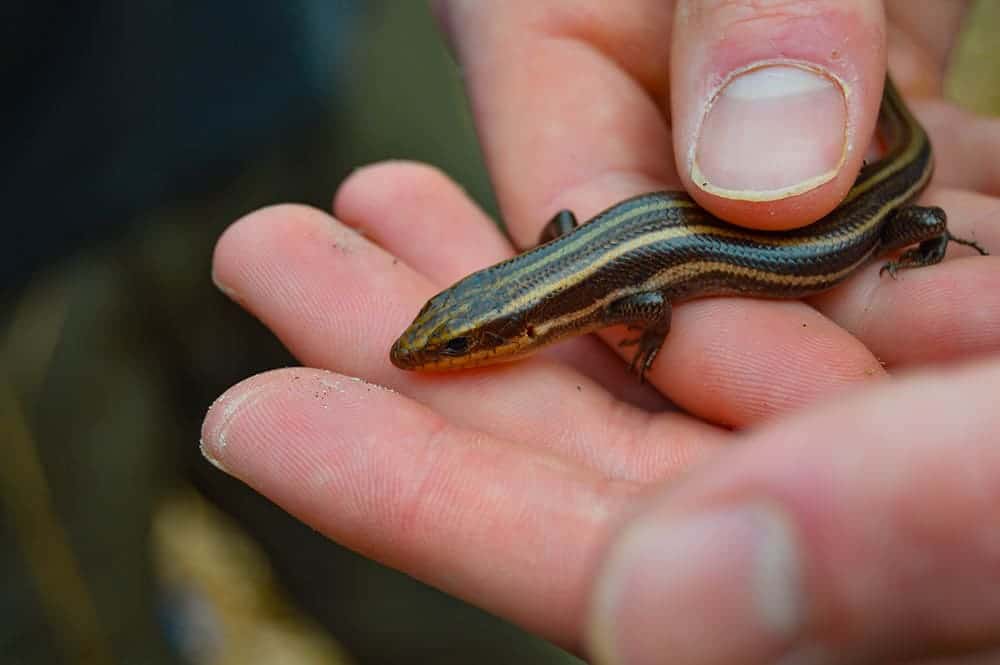
| Species: | Plestiodon anthracinus |
| Longevity: | 4 years |
| Good to own as a pet?: | No |
| Legal to own?: | Yes |
| Adult size: | 5–7 inches |
| Diet: | Carnivorous |
The Coal Skink is another lizard you can find in Kansas but only in the extreme east. It likes wooded hillsides with plenty of leaves close to a spring or a creek.
8. Six-Lined Race Runner
| Species: | Aspidoscelis sexlineatus |
| Longevity: | 6 years |
| Good to own as a pet?: | No |
| Legal to own?: | Yes |
| Adult size: | 6–11 inches |
| Diet: | Carnivorous |
The Six-Lined Race Runner is a fast lizard that moves quickly through low-lying vegetation reaching speeds up to 18 miles per hour. You can find it easily in Kansas, but its numbers are falling rapidly in Michigan due to habitat loss.
9. Eastern Fence Lizard
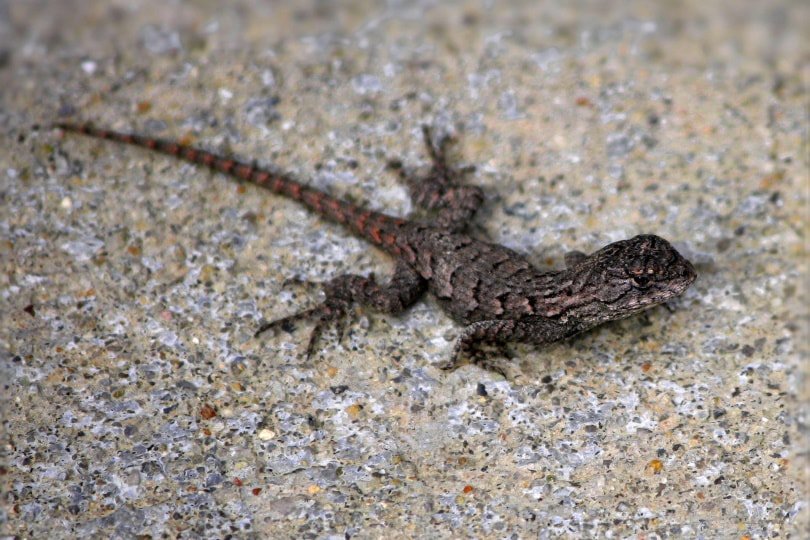
| Species: | Aspidoscelis sexlineatus |
| Longevity: | 5 years |
| Good to own as a pet?: | No |
| Legal to own?: | Yes |
| Adult size: | 4–8 inches |
| Diet: | Carnivorous |
The Eastern Fence Lizard has a wide distribution that extends to the east coast. Scientists believe that in the last 70 years, these lizards have evolved longer legs to help them escape fire ants, which are themselves an invasive species. You will usually see them in the morning by rock piles and tree stumps.
10. Texas Horned Lizard
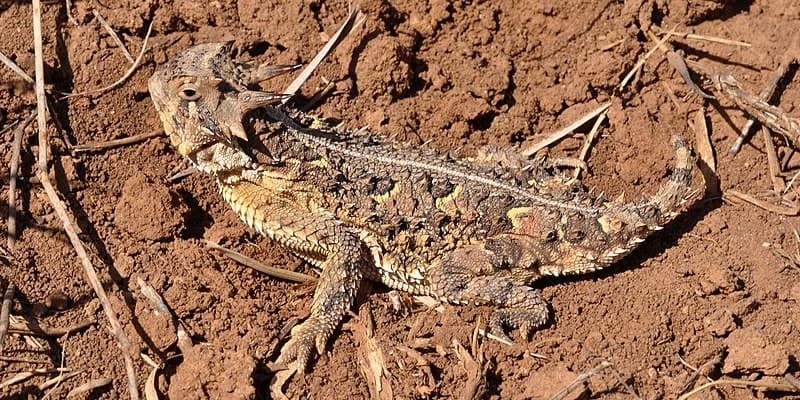
| Species: | Aspidoscelis sexlineatus |
| Longevity: | 7 years |
| Good to own as a pet?: | Yes |
| Legal to own?: | Yes |
| Adult size: | 3–5 inches |
| Diet: | Carnivorous |
The Texas Horned Lizard is a prehistoric-looking reptile native to the southern United States. It has horns protruding from its head as well as from the back of its wide body. Despite its menacing appearance, it’s extremely docile and makes a great pet.
11. Lesser Earless Lizard
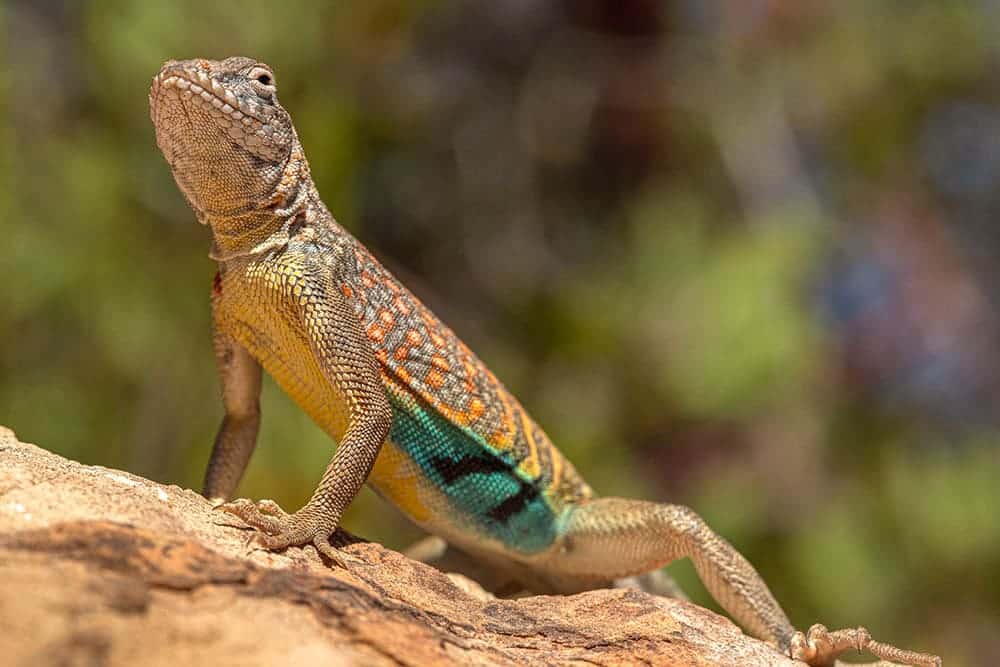
| Species: | Holbrookia maculata |
| Longevity: | 4 years |
| Good to own as a pet?: | No |
| Legal to own?: | Yes |
| Adult size: | 3–7 inches |
| Diet: | Carnivorous |
The Lesser Earless Lizard has a camouflaged coloring on its back that helps protect it from predators, and it prefers open but grassy hunting grounds when it forages for food.
12. Italian Wall Lizard
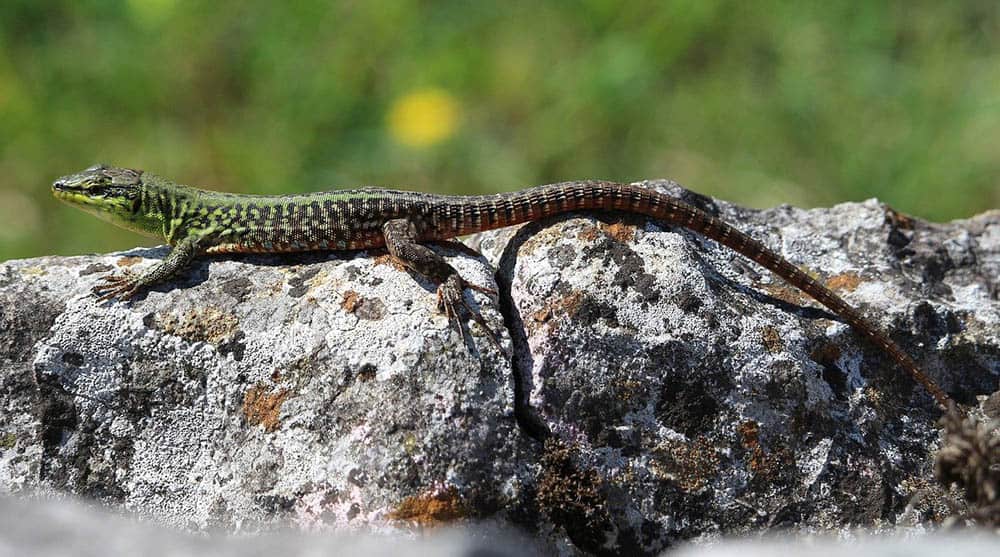
| Species: | Podarcis siculus |
| Longevity: | 2–5 years |
| Good to own as a pet?: | No |
| Legal to own?: | Yes |
| Adult size: | 3.5 inches |
| Diet: | Carnivorous |
The Italian Wall Lizard is an invasive species native to Bosnia, France, and Italy, but scientists have documented populations in Kansas, Pennsylvania, and other states in the US. It’s a colorful reptile that prefers shrubbery, rocky areas, and gardens.
13. Common Collared Lizard
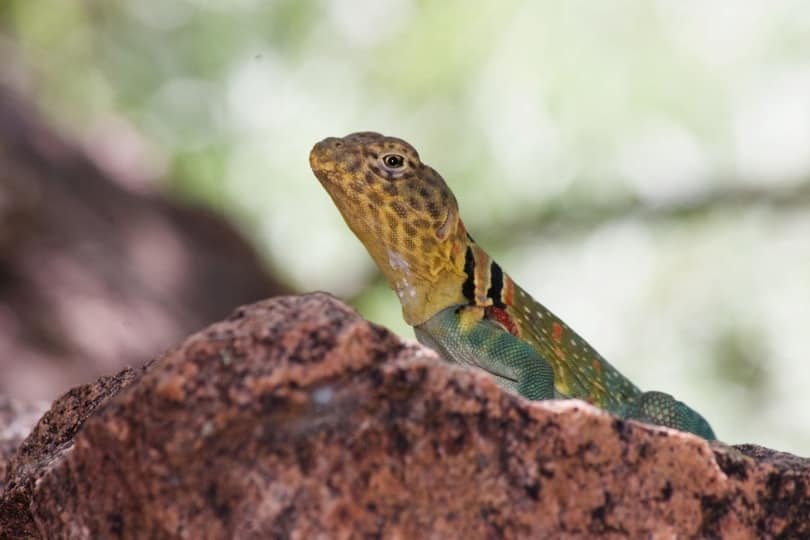
| Species: | Crotaphytus collaris |
| Longevity: | 5–8 years |
| Good to own as a pet?: | No |
| Legal to own?: | Yes |
| Adult size: | 8–15 inches |
| Diet: | Carnivorous |
The Common Collard Lizard is a colorful reptile with black bands around the neck and shoulder. It’s one of the larger species on this list, often growing 15 inches or more. It has a large head and powerful jaws. When threatened, it can run up to 18 MPH on its hind legs.

The 4 Types of Lizards in Kansas
1. Poison Lizards
Luckily, there are no poisonous lizards in Kansas, so you need not fear if you encounter one on your walks or in your garden.
2. Small Lizards
The smallest lizard on our list is also an invasive one. The Italian Wall lizard rarely grows to more than 3.5 inches long.
3. Big Lizards
Most of the reptiles on our list are medium-sized, but the Great Plains Skink, Broad Headed Skink, and Common Collared Lizard are likely the largest species you will find in Kansas.
4. Invasive Lizards
The Italian Wall Lizard is the only invasive species on our list. It’s native to Spain, but there are several feral colonies in the United States, including Kansas.

Conclusion
As you can see, there are several species of lizard you can find in Kansas. None of them are poisonous, so you can explore the environment without worry, and most of the species are extremely interesting and fun to watch. There are even a few that you can keep as a pet, including the Texas Horned Lizard. However, we recommend purchasing a captive bred reptile from a reputable breeder, so you don’t interfere with the environment.
We hope you have enjoyed reading over our list and found a few species you didn’t know were there. If we have helped you become more informed, please share this guide to the 13 lizards found in Kansas on Facebook and Twitter.
You might also like:
Featured Image Credit: Matt Jeppson, Shutterstock
